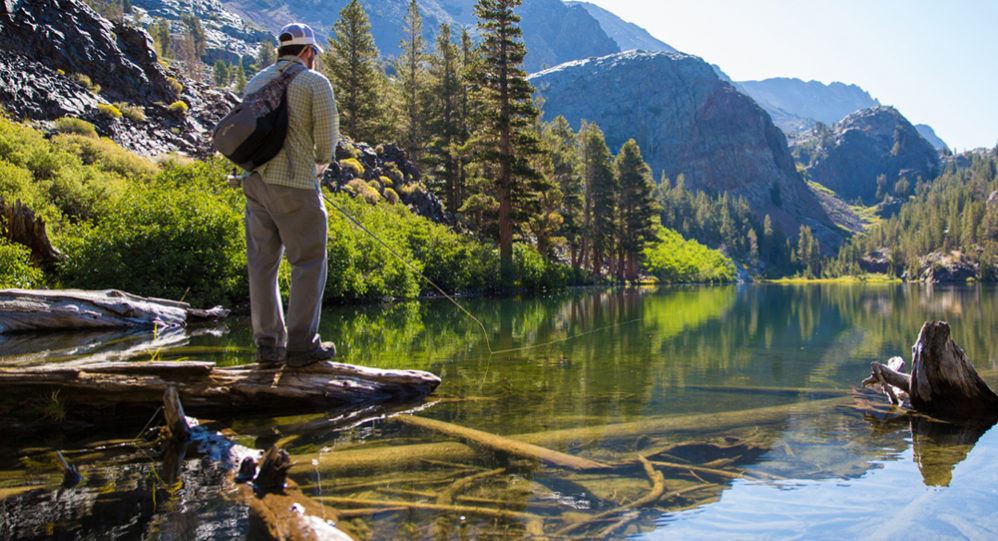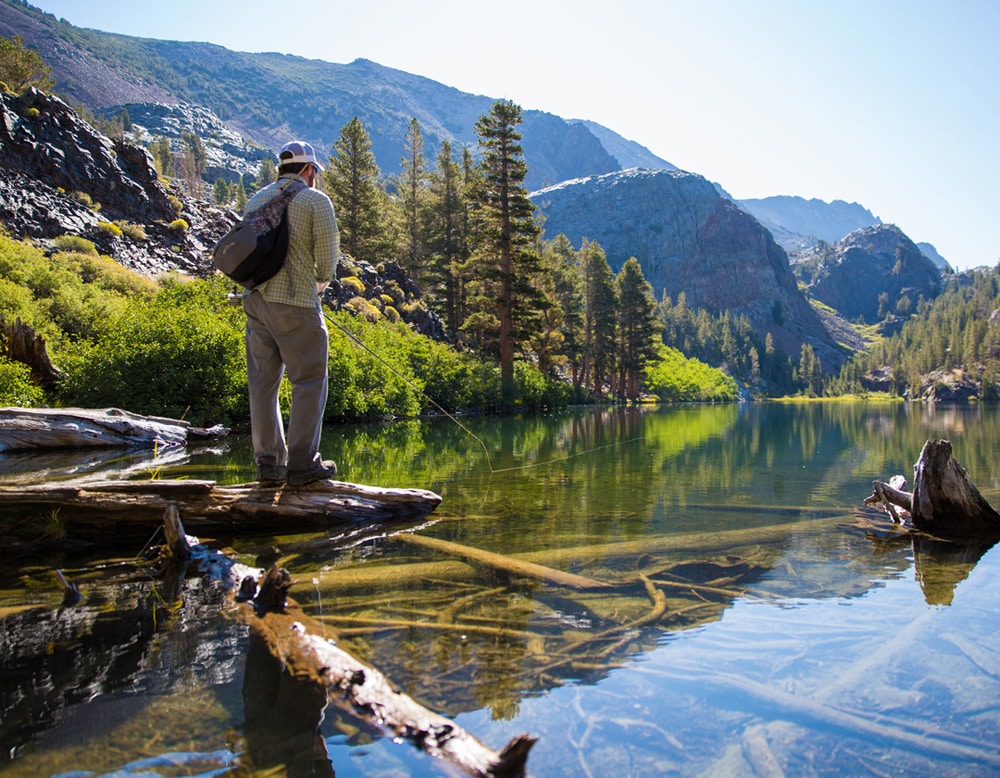
Fly fishing in Mammoth Lakes
By: David DeVoss
“In the Arctic half-light of the canyon all existence fades to a being with my soul and memories and sounds of the Big Blackfoot River, a four-count rhythm and the hope that a fish will rise. Eventually, all things merge into one, and a river runs through it.”
The moment I read A River Runs Through It, Norman Maclean’s 1976 novel about a stern minister with two sons growing up in rural Montana, I knew I wanted to master fly fishing.
Unfortunately, I grew up in Texas where rippling trout streams are as common as icebergs. Fishing for me meant going out on a bass boat and trolling for crappie while my Dad and one of his office buddies drank Falstaff beer. Clearly, the object of the exercise was not to catch fish, since I was the only one who was invited to bait a hook. It was, I suppose, meant to be a bonding experience, and it was. But trolling around a man-made lake for a gape-mouthed sunfish lacks the poetry of syncopated fly casting for rainbow or cutthroat trout.
So, recently I traveled to Mammoth Lakes, an Alpine community of 8,400 high in California’s Eastern Sierra. Mammoth probably is the most popular ski resort in the state, but in summer mountain streams swollen with pristine snowmelt feed some of the most beautiful rivers and lakes in the Southwestern U.S.
The Mammoth Lakes Basin (Twin Lakes, Lake Mary, Lake George and Lake Mamie), located above the city of Mammoth Lakes, offers wonderful angling opportunities for Rainbow, Brook and Brown Trout. All four lakes are stocked regularly throughout the season. As a bonus, the Mammoth Lakes Basin also receives heavy summer plants of trophy-sized trout, some weighing in at 10 to 12 pounds. These prize trout are fun to catch and delicious to eat.
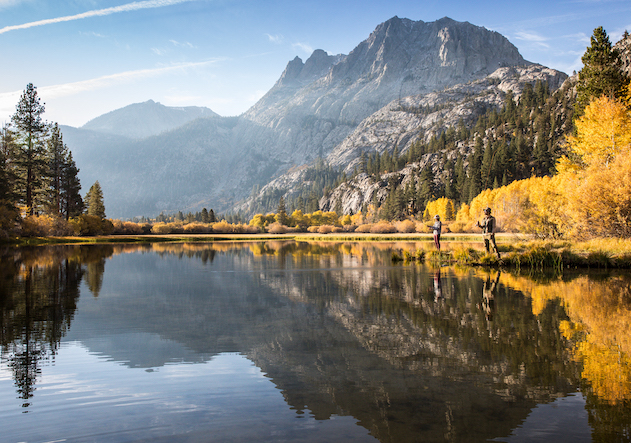
Mammoth Lakes has clear air, clean water and snowmelt lakes stocked with trout
But first I needed to learn how to cast a fly accurately without hooking a nearby tree or one of my ears. For that I needed Scott Flint, a full time Mammoth Lakes instructor who moves between ski slopes and trout streams depending on the season.
We were scheduled to go fishing early Saturday so I was a bit surprised when Flint called to say he’d be arriving Friday afternoon. “We’re going to the park,” he smiled, as we walked toward his truck. “Best place to learn how to fly cast.”
And for the next hour and a half that’s what we did, aiming lightly weighted lines back and forth toward designated spots on the grass. “You don’t need arm strength,” Flint smiled, after I smashed my weighted lure into the ground, fouling the line on my reel in the process. “It’s all in the wrist,” he explained. “Just gently flick your wrist.”
Shortly after dawn the following morning I was back in Flint’s truck and after quick stops for black coffee and a fishing license we were off to Horseshoe Lake. Horseshoe is not considered a good fishing lake since the trout are small and should be released after capture. But it’s close to town and I only had three hours before my next appointment. Besides, I wasn’t after food; I wanted to cast with accuracy, feel a fish take the hook and then reel in the little critter while it fought me all the way. “Why do fishermen pursue such a solitary often uneventful hobby?” I asked Flint while slipping on rubber boots and overalls. His response: “The tug is the drug.”
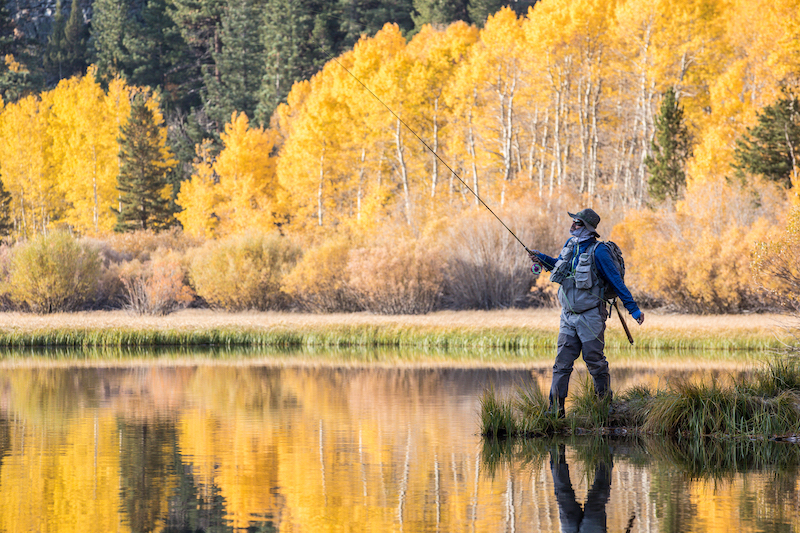
Trout fishing in California’s Eastern Sierra offers serenity, solitude and social distancing
No one fishes for trout in a group. Social distancing is built into the sport. “Fish tales” never are exchanged while people are fishing. The quest for trout is a solitary pursuit where companions are ripples on a lake, breeze filtering through a canyon and the burble of water rushing over submerged boulders.
I stood alone in the shallows, casting my line aimlessly before reeling it back slowly when without warning I saw the sight every angler dreams of: dozens of little dimples on the surface of the water, the telltale signs of trout just below the surface feasting on an insect hatch. At that point the practice in the park paid off and I cast the fly into the spot where the fish were feasting.
A trout took the hook, tugging the line taut as the rod bent toward the water. Flint had told me not to yank the pole or reel the fish in too quickly. So I just enjoyed the moment while drawing the trout closer.
Horseshoe is a catch and release lake so as soon as I netted the trout I removed the hook and put the fish back in the water. “Do fish have memories?” I asked Flint on the way back into Mammoth. “Will the fish we hooked today stop feeding and leave the area?”
“I think they have a realization of what happened, but no real memory,” he answered. “I’ve never hooked the same fish twice in five minutes. But they will keep biting which is good for us.”
Mono County fishing season starts the last Saturday in April and ends on November 15. This year, because of the coronavirus, it began June 1 because most of the lodges and motels were closed.
Anglers 16 and older must purchase an annual or one- or two-day fishing license. A one-day sport fishing license costs $15. For $23.50 you can buy a license good for two consecutive days. If you fall in love with the sport and move to California, an annual fishing license is just $47. Fishing licenses may be purchased in several locations around Mammoth Lakes. For additional information about fishing regulations visit the Department of Fish & Wildlife website, call 760-934-2664 or download 2020-2021 Freshwater Sport Fishing Regulations (PDF).
The Department of Fish and Wildlife offers two free fishing days each year, one on a Saturday in July and another on a Saturday in September. These dates are the only days you may fish without a license.
The good news is that it’s possible to fish year round in California’s Eastern Sierra if you stick to the catch-and-release fisheries of the Upper Owens River above the Benton Bridge to Big Springs, the East Walker River below Bridgeport Reservoir and Hot Creek.
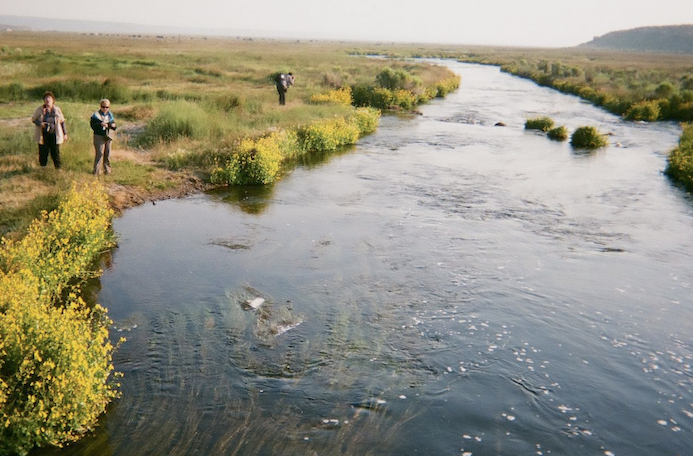
Fishing guides will escort novice anglers into the back country to fish in more remote streams
Find out the best times to fish and where the fish are biting with fishing reports and forecasts for lakes and streams in the area. The Crowley Lake Fish Camp Report covers 60-sq. mile Crowley Lake
The Troutfitter is Mammoth Lakes largest fishing store and guide service. You can pick up free maps and get access to 18 bonded fishing guides. The store also offers a First-Time Beginner’s Package for people who never have fished before.
The Troutfitter/Trout Fly Report offers daily updates on flow rates, water conditions and which flies are having best results for all area lakes rivers and streams.The Sierra Drifters Guide Service is a reliable resource for experienced guides who can outfit you with the right tackle and gear, take you in a boat on one of the area lakes or accompany you into the back country to find the best fishing holes.
Mammoth Lakes has a variety of areas for the fishing enthusiast.
Located 12 miles south of Mammoth Lakes, Crowley Lake is one of the more developed fishing areas. It has a full service marina, rental cabins, RV sites, 90 rental boats and a general store. There’s even a restaurant that provides great trout dinners. The downside is that with convenience comes campers who often prefer water and jet skiing, kayaking and paddle boarding to fishing. Fortunately, the lake is large enough that these activities are kept fairly separate.
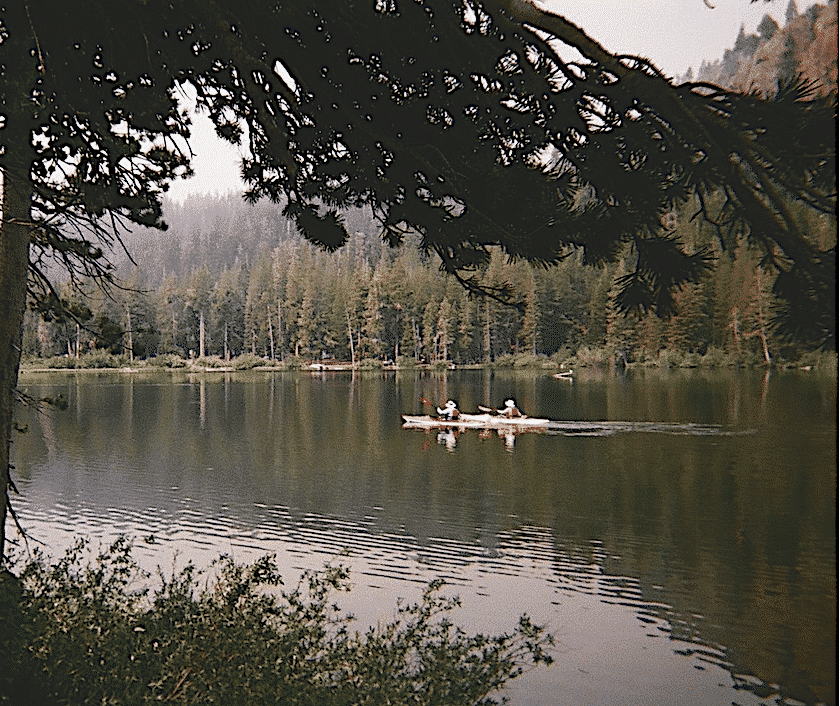
Mammoth Lakes, California offers boating and other water recreation in addition to fishing
Crowley Lake is stocked by the Department of Fish and Wildlife on their regular schedule. Crowley Lake features some unique regulations; inquire at the Crowley Lake Fish Camp before you head out to catch the big one.
For those anglers interested in catching a limit of pan-sized rainbows or wild brown trout, Mammoth Creek is full of them. Running east from the Old Mammoth meadow area to below U.S. Highway 395, the small stream offers close to 10 miles of fabulous fishing.
Convict Lake, with its crystal-clear water, is full of beautiful rainbow trout and brown trout. Convict Lake is located seven miles south of the city of Mammoth Lakes and is stocked weekly during the season. It offers boat rentals, campgrounds, public showers, a general store and an excellent restaurant.
Rock Creek Lake, Long Lake and countless small tarns all have an abundance of trout. Golden, Brook, Rainbow, Brown and Cutthroat can be found in these alpine lakes. Rock Creek offers some of the most exciting creek fishing in the region, as trout up to 5 pounds or more have been pulled out of the creek’s rushing waters. The creek is stocked once a week from opening to closing day. Rock Creek has a general store where you’ll find fishing tackle necessities, pole rentals, licenses and food.
Some of the best fly fishing is along the San Joaquin River in the Reds Meadow area. At Hot Creek, try your luck at catch-and-release fishing with barbless hooks.
Discover the June Lake Loop with its four glistening lakes: June Lake, Gull Lake, Silver Lake and Grant Lake. All the lakes are stocked with trophy-sized trout. There are five marinas, tackle shops, boat and float tube rentals. Rush Creek is the perfect spot to test your fly fishing skills.
Join in the fun of one of the numerous fishing events and derbies held throughout the season, such as the Opening Weekend Fishmas Festival, 50 Days of Fishmas, Convict Lake Fishing Derbies, Children’s Fishing Festival, Crowley Lake Stillwater Classic, Free Fishing Days and more.![]()
David DeVoss is editor of the East-West News Service


